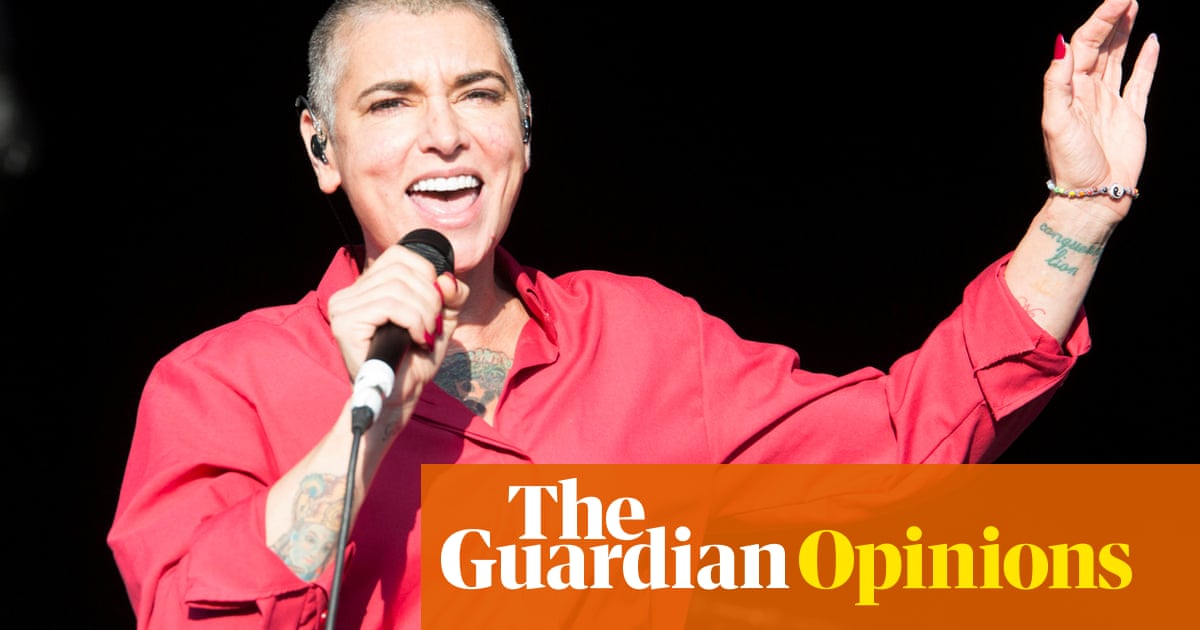
In March 2016, Sinéad O’Connor, who died last month at 56 and whose funeral takes place today in Bray, Ireland, went missing. I remember this specifically because the Telegraph ran a live blog on the singer’s whereabouts after she had posted suicidal thoughts. A live blog. I pointed out to an editor at the paper that rolling updates about a person going through a severe mental health episode, an episode that might have ended fatally – and for all they knew, already had – was neither responsible nor compassionate. It was, coincidentally, Mental Health Awareness Week.
On that occasion, O’Connor was found safe, if not well. It was not the only brutal public example of how her mental illness manifested, and mental illness was the blunt – accurate – term she used. Of contemporary public figures, O’Connor was perhaps the one whose experiences of psychiatric disorder – she was diagnosed with bipolar disorder, borderline personality disorder, and complex PTSD – spoke most to the realities of those who live with, or endure, the kind of warped brain that can make even the simplest thing feel like a Sphinx’s riddle.
From the confusion of multiple, overlapping diagnoses, to the trial-and-error of medication, O’Connor, both wittingly and unwittingly, elucidated all of it. The chaos and heartbreak during the bad times: the suicidal ideation (and attempts); the frothing anger; the sectionable manic insomnia. The making a spectacle of oneself online, the screwing up at work, the lashing out at friends and family … and then the crushing, paralysing shame and remorse that follows (in 2017, O’Connor apologised for “viciously” insulting family members). She openly grappled with adverse childhood experiences; and ruminated on whether a person is created mad or made mad.
Everything that mainstream public discourse around mental health shrinks from, O’Connor put front and centre. It was far from the sanitised – often monetised – Instagram version, which, unfathomably, enragingly, verges on the aspirational. The way people responded to O’Connor’s most vulnerable moments undermined our ostensibly enlightened, destigmatised epoch. When O’Connor uploaded a rambling, distressed 12-minute video to Facebook in 2017, there were just as many Twitter jokes and memes as concerned missives. Here was the raw reality of someone in the midst of crisis, and the response was, in large part, mirth or disgust. Afterwards, O’Connor spent time in hospital, which she would do frequently, describing the (private) St Patrick’s university hospital in Dublin as a sort of second home (she dedicated her memoir to its staff).
O’Connor said the “millions of people” with mental illness made her feel less alone. But she noted that not everyone “has the resources I have”. Mental health services have been decimated in both the UK and Ireland. In England, the number of beds has been slashed by 25% since 2010. In Ireland, paediatric admissions have fallen by 40% in a year due to lack of staff. The stats are endless in their deathliness. A few days after O’Connor died, a man relayed to the Irish Independent an encounter he had had with the singer: she had comforted him in the car park of St. Patrick’s, where his son was receiving treatment. “I’m concerned that if we hadn’t had private healthcare, my son might not have made it,” he told the paper.
Last year, O’Connor’s son Shane reportedly absconded from suicide watch at the Tallaght hospital, a state-run facility in Dublin. He ended his life, aged 17.
O’Connor was shattered by her son’s death, as any parent would be. Add unbearable grief to the mix. There was one other thing: fame. While O’Connor was right in her observation that mental illness does not discriminate, she nevertheless said: “it didn’t really help in terms of being well or a stable person … that I was getting kicked around by the media for years”. After O’Connor’s death, Lily Allen, who has been relentlessly hounded by the tabloid press, alluded to the profound effect this has.
In her unmitigated candour, O’Connor made a difference to genuine mental health awareness, or rather, awareness of mental illness. But it wasn’t just her words. After the death of her son, she called for system reform and an inquiry, so that others might be spared the same agony. A decade ago she launched a mental health programme in County Kerry. She quietly paid for strangers’ counselling.
I don’t know how O’Connor died. But as well as her incredible music, her wit and verve and strength, her activism, she leaves a legacy of representation for those of us who know what it’s like to have their headphones confiscated in the inpatient wards, who know what it’s like to look in the mirror and see something not quite human. Not the hashtags or the reels or the self-diagnosis of ADHD after leaving dishes in the sink for two days (try weeks, try months); not the mantras written on a Post-it that are somehow supposed to assuage hours of daily skin-picking or a two-year waiting list. Sinéad O’Connor was a truth-teller. Perhaps her most visceral truth of all was how she showed us her suffering – and how she was desperate for it not to be in vain.
Hannah Jane Parkinson is a Guardian columnist
In the UK and Ireland, Samaritans can be contacted on 116 123 or email jo@samaritans.org or jo@samaritans.ie. For more information visit www.samaritans.org. In the US, the National Suicide Prevention Lifeline is at 800-273-8255 or chat for support. You can also text HOME to 741741 to connect with a crisis text line counselor. In Australia, the crisis support service Lifeline is 13 11 14. Other international helplines can be found at www.befrienders.org
Comments on this piece are premoderated to ensure discussion remains on topics raised by the writer. Please be aware there may be a short delay in comments appearing on the site.












